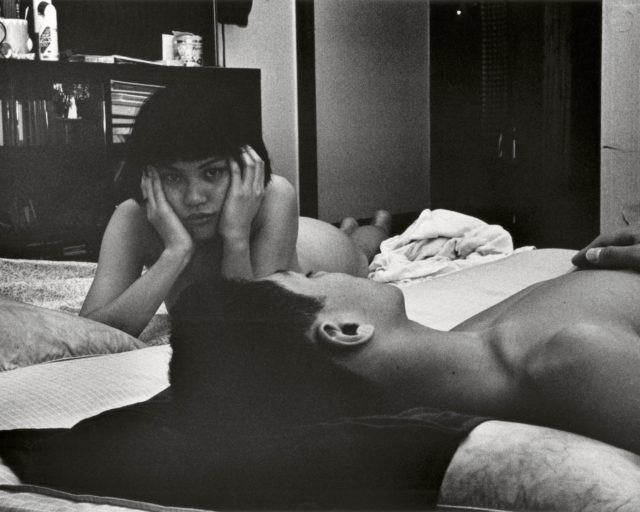Along the Route of Fidel's Funeral
When Fidel Castro died in November, photographer Noah Friedman-Rudovsky followed the final journey of Cuba’s comandante.
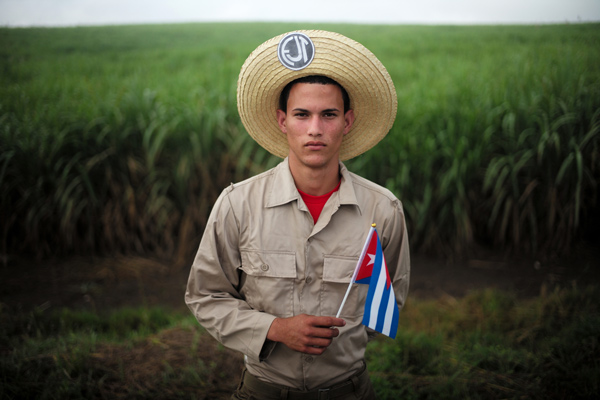
Noah Friedman-Rudovsky, The faces of a diverse nation lined up to watch Fidel’s remains pass by, Cuba, 2016
Courtesy the artist
What’s the geography of a life? The town where one’s born and where one is raised; the far-off cities or nearby states to which one later treks for pleasure or need; the house or humble flat where one ends up, and as they say, reproduces, dies: these are the sites, for most humans, that chart the trip from sunrise to ‘set. Some people’s maps expand little beyond where they start; some stride the globe. The details of most maps, either way, concern few beyond their subjects and their kin. Those of some people—the sort about whom biographies are written—occupy many more. A few maps, because of their worldly itineraries and their impacts, become allegories: they exemplify journeys that symbolize key currents in, or crucial truths about, their nations or age.
Fidel Castro Ruz was one such person. When Cuba’s late comandante died in November, at ninety, he had for nearly six decades been both his country’s foremost celebrity and its plenipotent leader. He was a villain to those who fled his rule, a hero to those who admired his courage and ideals, and an outsized figure on the world stage. His map touched places ranging from South Africa, where he is loved for sending Cuba’s troops to fight Apartheid in the ’70s, to Miami—the city his cousins built to loath him. But in Cuba itself, his story is also simpler. It is the tale of a rancher’s son, from the island’s rural east: a country boy who launched a revolt in that region’s Sierra Maestra mountains, and after his revolution’s victory in 1959, rode up this huge 700-mile island’s spine to seize its distant capital of Havana.
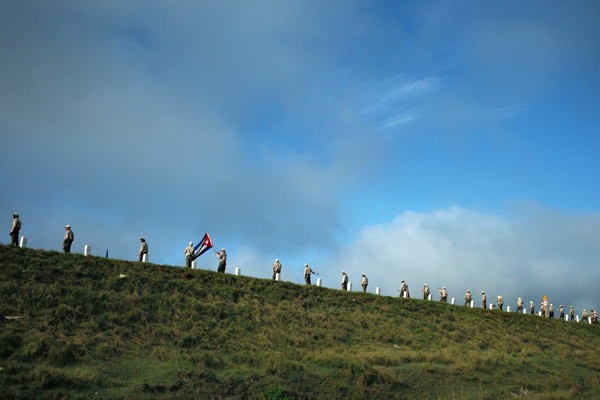
Noah Friedman-Rudovsky, Cubans gathered along the length of the nation’s highway for days to watch Fidel’s ashes make a cross country trip back to the region where we has born and where the revolution began, 2016
Courtesy the artist
When Fidel’s brother Raúl made a momentous speech to announce his death in that same city, fifty-six years later, the route between Cuba’s eastern heartland and its capital was the map every Cuban thought of—the map of both Fidel’s life and his revolution. On November 25, 2016, Raúl Castro spoke not as Fidel’s brother but as the current head of Cuba’s Communist Party. Raúl announced the “physical disappearance” of the party’s eternal comandante and then described how Fidel’s passing would be marked by his country. Fidel’s funeral cortège would trace the same route as their revolution, said Raul, but in reverse. Fidel’s remains would be cremated, per his wishes, and his ashes would be carted, behind a small Jeep like the one he rode to Havana in 1959, back from whence he came. This humble procession, over nine days of national mourning during which no alcohol would be sold or music performed, would roll Cuba’s length to bring the comandante home. Each mile of the way, Cubans lined the road. Noah Friedman-Rudovsky—a photographer whose experience with lefty leaders in Latin America includes working as personal photographer of President Evo Morales of Bolivia for the past decade, but who has been documenting life in Cuba for longer than that—accompanied the comandante’s ashes for their whole route.
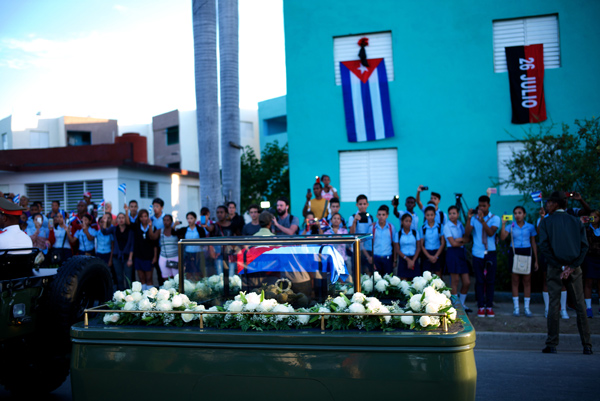
Noah Friedman-Rudovsky, The ashes of the physically large Fidel were carried in a small, understated box, draped by a Cuban flag and dragged by a military Jeep, 2016
Courtesy the artist
The cavalcade of official grief got under way in Havana, with a mass gathering of Cuban citizens and visiting dignitaries in the great concrete expanse of the capital’s Plaza de la Revolución. As it did, the nation’s TV screens, which would for nine days devote round-the-clock coverage to Fidel’s farewell, aired the convocation’s boring speeches. But that night and the next morning, as the Jeep toting Fidel’s ashes left behind the dignitaries in the capital to commune with rural Cubans in el campo, live shots of the procession interspersed archival images from Fidel’s life, many of them rendered in slow motion and accompanied by aching string music. The images overlaid with the government’s official slogan of mourning, Yo Soy Fidel (“I am Fidel”). They recalled the main moments in a life—or at least the ones the state wanted Cubans to recall—that began in 1926 on the ranch of an immigrant from Galicia, Spain who got his start as an overseer in the sugar fields of Cuba’s Oriente before he grew rich owning them.
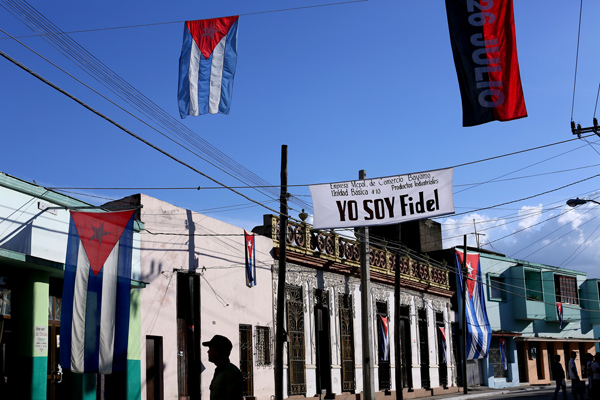
Noah Friedman-Rudovsky, The slogan “I am Fidel” rang out across the country, Cuba, 2016
Courtesy the artist
It was the ambition of Fidel’s mean rancher dad that saw him and his brothers sent to the top Jesuit boarding school in Cuba’s eastern capital of Santiago. It was Fidel’s own that took him from Cuba’s second city to its first, to attend law school at the University of Havana. As a brash and brilliant student activist, he became a prominent and fiery critic, leading with his barrel chest, of Cuba’s corrupt leaders in the 1940s. But then it was back home in Santiago where he launched his career as a revolutionary that saw him, in 1953, lead a doomed attack on an army barracks in which several of his friends were killed but that Fidel managed, by a form of luck either dumb or destined, not merely to survive but to declare to his countrymen, during his ensuing trial for treason, that “history will absolve me.” That saw him return to eastern Cuba, after a stint in jail and a stint in Mexico, in a little boat whose twelve surviving invaders stole into the mountains and gathered around their leader, like hirsute apostles of Christ, to convince Cuba’s poor and its liberals of his cause. That saw him ride west toward Havana, in his little Jeep and to the exulted cheers of all. That saw his revolution’s ambit quickly grow, for his crew of believers and zealots, to include such quixotic tasks as eliminating illiteracy on his poor island (which Fidel’s volunteers quickly did). After he nationalized Cuba’s land to estrange Havana from Washington, and then found a new Soviet patron, Castro expressed not relief but frustration when humanity avoided the nuclear precipice of October 1961: he was peeved that Soviet leader Nikita Khrushchev backed down from launching missiles at the Yanks.
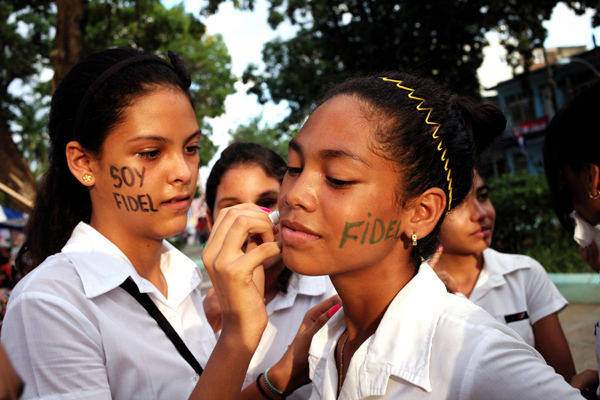
Noah Friedman-Rudovsky, Girls paint the words “I am Fidel” in marker in the town of Bayamo, Cuba, 2016
Courtesy the artist
This hard-headedness—what Cubans dub gallego and Brits would call bloody-minded—was always there, too. It’s what saw Fidel, in the revolution’s early decades, betray a grave intolerance for Cubans who were less Communist, or more gay, than he was. It’s also what helped him, when the Soviet bloc fell and with it the rusting Cuban economy’s lifeblood, not merely retain his firm grip on power but sustain his state’s vaunted systems for providing free healthcare and good schools for all Cubans. And it’s what also saw him, against all odds and after perhaps 600 distinct attempts on his own life, die not from an assassin’s bullet, or a poisoned cigar, but of old age in bed.
The life story reads like a fable. This befits a man who counted among his best friends Gabriel García Márquez. One used to wonder, hearing tales of Fidel dining in Havana with magical realism’s foremost exponent, what the comandante and novelist spoke of. It was hard not to suspect, learning of how Cuba planned to mark his demise, that one thing Fidel himself discussed with “Gabo” was how to imbue the aftermath of his death, long foretold, with optimal narrative symmetry and heft. The number of days of mourning proclaimed by Raúl—nine—wasn’t accidental: in Cuba, nine days is the sum of time that adepts of santería, the Yoruba-derived faith that is one of the island’s religions, believe a person’s soul takes to leave its body. And so it was, as Fidel’s soul rose from the little box wrapped in a Cuban flag, that his Jeep pulled his ashes the length of the island’s carratera central—its national highway—and through cities whose every name resounds, in Cuba’s history or Fidel’s story or both, with its own meaning.

Noah Friedman-Rudovsky, School children were bussed in en masse to attend the caravan, Cuba, 2016
Courtesy the artist
The caravan rolled past the old slave port that birthed Cuban rumba—Matanzas—and through the central city—Santa Clara—where Fidel’s great lieutenant during the revolution, Che Guevara, attacked a train to break the dictator Fulgencio Batista’s forces. It rolled from Sancti Spíritus to Ciego de Ávila to Camagüey; from Las Tunas to Holguín, and to Bayamo—the eastern city, site of a famous battle in Cuba’s nineteenth-century war for independence that now lends its name, in “La Bayamesa,” to its national anthem. Each mile of the way, Cubans lined the road. Friedman-Rudovsky rose before dawn to be ready when the cortège departed whichever well-guarded rural army base Fidel’s ashes spent the night, riding in, or often atop, a car rolling with them.

Noah Friedman-Rudovsky, On the final night of mourning, Cubans filled the plaza in Santiago de Cuba for official remarks by Raúl Castro, 2016
Courtesy the artist
Some of the faces his lens found belonged to people who had to be there: rural nurses or farmworkers employed by the state, bused to the roadside as a duty. Others—townspeople and students, retirees, and layabouts—came because they wanted to. Their tears said so; their aunts and cousins’ presence did, too. Theirs was a farewell to family, signaled with waving flags or smartphones: the parting of a grandfather who, resented or cherished or a complex mix of both, had earned the pause his death prompted. And as the comandante’s posthumous retinue reached the base of the Sierra Maestra by Santiago, the great square in Cuba’s oldest city filled, at sunset, with thousands of mourners. Some chanted “Yo Soy Fidel!” Many wore armbands noting the date in 1953—July 26—when Fidel launched his doomed attack on the Moncada army barracks here.
That night, Raúl Castro gave another speech to the assembled. He declared, in a homily to his brother’s role in Cuban history, how Fidel had decreed that no park or avenue or public site be named after him, so as to “avoid any manifestation of a cult of personality” in Cuba. This may have beggared belief: Raúl was invoking a man who thought it fit to dominate his country’s airwaves and its public sphere, for decades, with his hours-long speeches. But this was Fidel’s wish.

Noah Friedman-Rudovsky, A young military serviceman salutes the fallen leader’s caravan, Cuba, 2016
Courtesy the artist
Cuba now enters a new and uncertain age. Havana’s recent rapprochement with the administration of former president Barack Obama signaled a recognition, here, that attracting foreign capital—if not necessarily embracing capitalism—is increasingly key to the island’s future. Cuba now confronts a new leadership in Washington, whose buffoonish head has already tweeted his unwillingness to deal with his island neighbor. How the drama between these two will go is hard to say. But as Cuba’s ruling party confronts this new foe, Cuba will be without the leader who defined its modern history.
The morning after Raúl’s final speech, in a cemetery not far from where he and his brother went to high school, Fidel’s ashes were buried next to the grand mausoleum of José Martí, the poet-laureate of Cuba’s nineteenth-century war for independence. The simple granite boulder under which they were laid was inscribed with a single word—FIDEL. That is now his official monument. But the larger monument, at least in the days after he passed, was the faces of his people—weary or hopeful, wary or sad—who looked on. As his remains passed on their final journey, the people of Cuba saw themselves reflected in his ashes’ glass case or in the sympathetic lens of a photographer who, filling that map with them, was there for it all.












